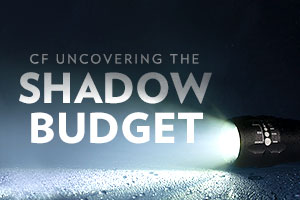Media

Reducing the State’s Cash Stockpile Can Help Balance the Budget
Lawmakers considering balancing the budget with borrowing and higher taxes could opt for a responsible alternative: drawing down funds from the shadow budget's “banking accounts.”
But first, let’s take a step back. What’s the shadow budget? The shadow budget is a huge portion of state spending—about 60 percent of state government's cost—that's largely hidden from taxpayers. The General Fund dominates budget discussions, but the shadow budget contains more than 150 “special funds” whose costs are largely unknown to the public.
CF has consistently called for prioritizing future spending in the state’s shadow budget. However, there is another aspect to consider.
As Nate pointed out, Pennsylvania holds nearly $73 billion in surplus fund balances, including $11 billion in the Treasury's shared pool. This includes funds for many of the state’s shadow budget programs. The funding for these and other programs are deposited into three investment pools. All three pools serve a different purpose:
- Liquid Asset Pool – Think of this pool as a checking account. The pool’s purpose is to provide funds quickly for state agencies. This requires the state to invest these funds conservatively and for only a short period of time.
- Common Investment Pool – This pool could be described as a type of savings account. The funds in this pool aren’t immediately available. Rather, they’re used to generate an investment return—over time—for the state.
- Treasury Managed Cash Pool – Acts as a “short-term investment vehicle” for cash from funds that have not been utilized by investment managers. As a 2014 Treasury report makes clear, these cash balances enjoy investment benefits but remain ready for future use by investment managers.
Instead of raising taxes, policymakers could utilize these fund balances to cover bills incurred last year. These surplus funds indicate the state is collecting much more than it needs to distribute annually. The chart tracking the Public Transportation Trust Fund balance below is illustrative.
Tens of millions of dollars are amassed in these shadow funds and then used by the Treasury to finance investments. To ignore the billions of dollars in shadow fund balances while increasing taxes on working families is simply unconscionable.
State Treasurer Joe Torsella recently authorized a $750 million loan from these fund balances to keep state payments flowing. But he did so while criticizing the legislature for failing to fix the state’s fiscal imbalance. He made it a point to note that the commonwealth’s short-term investments aren’t a de facto rainy day fund.
In a sense, he’s right. The state shouldn’t have to rely on one-time transfers to pay for overspending. But it also should not sit on funds worth billions of dollars while contemplating tax hikes and borrowing on the backs of taxpayers. Making good use of these fund balances to help foster a transition to sustainable future budgets is the most practical and fiscally responsible option available.
As for dealing with the estimated $600 million deficit this fiscal year, policymakers can focus on redirecting tax revenue from shadow funds to the General Fund budget on a permanent basis. A few of the most obvious examples include the Keystone Recreation, Park and Conservation Fund, Agricultural Conservation Easement Purchase Fund, or the state’s mass transit funds—all of which are funded, in part, by tax dollars.
Coupling the utilization of these fund balances with liquor privatization, welfare reform, and even gambling expansion creates a clear path to a balancing the budget without tax increases.